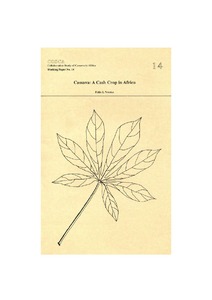| dc.contributor.author | Ehui, Simeon K. |
| dc.contributor.author | Spencer, D. |
| dc.date.accessioned | 2019-12-04T11:26:18Z |
| dc.date.available | 2019-12-04T11:26:18Z |
| dc.date.issued | 1993 |
| dc.identifier.citation | Ehui, S. & Spencer, D. (1993). Measuring the sustainability and economic viability of tropical farming systems: a model from sub-Saharan Africa. Agricultural Economics, 9(4), 279-296. |
| dc.identifier.issn | 0169-5150 |
| dc.identifier.uri | https://hdl.handle.net/20.500.12478/4530 |
| dc.description.abstract | New technologies must be developed in sub-Saharan Africa which are sustainable and economically viable. This paper discusses a methodology for measuring the agricultural sustainability and economic viability of tropical farming systems for new technology evaluation. The approach is based on the concept of interspatial and intertemporal total factor productivity, paying particular attention to valuation of natural resource stock and flows. Agriculture is a sector which utilizes natural resources (e.g. soil nutrients) and the stock and flows of these resources affect the production environment. However, in many cases, the stock of these resources is beyond the control of the farmer and must be accounted for in an agricultural sustainability and economic viability measurement. For example, soil nutrients are removed by crops, erosion or leaching beyond the crop root-zone, or other processes such as volatilization of nitrogen. Agricultural production can also contribute to the stock of some nutrients by leguminous plants such as agroforestry systems. Using a data set available at the International Institute of Tropical Agriculture, we compute the intertemporal and interspatial total factor productivity indices for four cropping systems in southwestern Nigeria using stock of major soil nutrients as the natural resource stock. Results show that the sustainability and economic viability measures are sensitive to changes in the stock and flow of soil nutrients as well as the material inputs and outputs. Where the contribution of natural resource stock and flows are important (such as in the case of alley cropping), the measures provide markedly different results from conventional TFP approaches. The advantage of this approach is that interspatial and intertemporal total factor productivity measures are computed using only price and quantity data, thus eliminating the need for econometric estimation. |
| dc.language.iso | en |
| dc.subject | Sustainability |
| dc.subject | Farming Systems |
| dc.subject | Technology |
| dc.subject | Farmers |
| dc.subject | Economics |
| dc.subject | Nutrients |
| dc.title | Measuring the sustainability and economic viability of tropical farming systems: a model from subSaharan Africa |
| dc.type | Journal Article |
| dc.description.version | Peer Review |
| cg.contributor.affiliation | International Livestock Research Institute |
| cg.contributor.affiliation | International Institute of Tropical Agriculture |
| cg.coverage.region | Africa |
| cg.coverage.region | East Africa |
| cg.coverage.region | West Africa |
| cg.coverage.country | Ethiopia |
| cg.coverage.country | Nigeria |
| cg.isijournal | ISI Journal |
| cg.authorship.types | CGIAR multi-centre |
| cg.iitasubject | Nutrition |
| cg.iitasubject | Livelihoods |
| cg.iitasubject | Smallholder Farmers |
| cg.iitasubject | Socioeconomy |
| cg.iitasubject | Farming Systems |
| cg.accessibilitystatus | Limited Access |
| local.dspaceid | 100780 |
| cg.identifier.doi | https://doi.org/10.1016/0169-5150(93)90018-8 |

